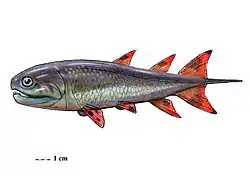Ceratodontoidei
Ceratodontoidei is a suborder of lungfish that is defined as "the clade including all taxa more closely related to Lepidosiren, Neoceratodus and Gnathorhiza than to Uronemus, Conchopoma and Sagenodus". Members of this suborder are known as ceratodontoids. The only presently extant lungfish in the families Neoceratodontidae and Lepidosirenidae belong to this suborder.[1][2]
| Ceratodontoidei | |
|---|---|
 | |
| Neoceratodus forsteri, a neoceratodontid | |
 | |
| Lepidosiren paradoxa, a lepidosirenid | |
| Scientific classification | |
| Kingdom: | Animalia |
| Phylum: | Chordata |
| Clade: | Rhipidistia |
| Clade: | Dipnomorpha |
| Order: | Dipnoi |
| Suborder: | Ceratodontoidei Nikolski, 1954 |
| Families | |
|
See text | |
Taxonomy
The suborder was formerly defined as being within the order Ceratodontiformes and including the families Neoceratodontidae and Ceratodontidae, as they were formerly thought to be closely related to one another.[3] However, phylogenetic analyses indicate that this classification is paraphyletic, as Ceratodontidae was found to be a sister group to a clade containing Lepidosirenidae, which was formerly classified as Lepidosireniformes, a distinct order from Ceratodontiformes. Due to this, Lepidosireniformes and Ceratodontiformes were redefined as families within the order Dipnoi, and Ceratodontei was redefined as including all lungfish more closely allied with Neoceratodontidae and Lepidosirenidae.[1]
The current taxa within the suborder are listed below:
| Ceratodontoidei |
| ||||||||||||||||||||||||||||||||||||
The oldest fossils from this suborder are of Gnathorhizidae from the Late Carboniferous. Phylogenetic evidence indicates that the suborder itself originated slightly earlier in the late Carboniferous and rapidly diversified into the multiple families between then and the start of the Permian.[1][4]
References
- Kemp, Anne; Cavin, Lionel; Guinot, Guillaume (2017-04-01). "Evolutionary history of lungfishes with a new phylogeny of post-Devonian genera". Palaeogeography, Palaeoclimatology, Palaeoecology. 471: 209–219. doi:10.1016/j.palaeo.2016.12.051. ISSN 0031-0182.
- "Fossilworks: Ceratodontoidei". fossilworks.org. Retrieved 2020-10-19.
- "Ceratodontoidei - Wikispecies". species.wikimedia.org. Retrieved 2020-10-19.
- "Fossilworks: Gnathorhizidae". fossilworks.org. Retrieved 2020-10-19.

.jpg.webp)


